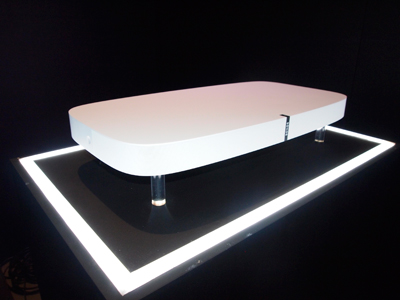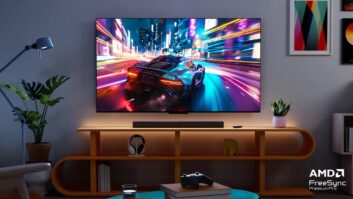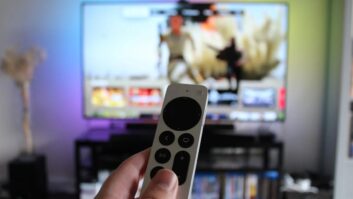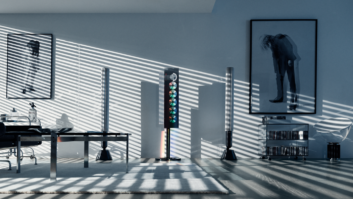
Industrywide sales of under-TV speaker bases are down, but wireless-multiroom-audio supplier Sonos expects its first under-TV speaker to succeed where others have failed.
The company plans April 4 availability of the $699 Playbase to complement its $699 Playbar soundbar, launched in 2013.
Playbase will succeed, Sonos executives told TWICE, because of “radical simplicity” in setup and use, a svelte 2.28-inch height that doesn’t look clunky under a TV, and an understated rounded-off design that looks good on top of almost any piece of furniture. It’s available in black or white.
In addition, Playbase’s 28.4-inch width and 14.2-inch depth were carefully researched to ensure the speaker system fits on top of almost any piece of furniture and under most popular 40- to 59-inch TVs, which account for 70 percent of TVs on the market, said Ian Popkin, product creation leader.
Playbase’s dimensions are “wide enough for TVs but not too big for the furniture that you have,” added Michael Papish, global platform marketing director. “It took more than three years to create the form factor so it would disappear and deliver great sound.” Playbase looks like a “monolithic slab without seams,” thanks to a glass-filled polycarbonate exterior that minimizes vibration and is strong enough to withstand the weight of a TV, he said.
See: Sonos Embracing Alexa To Stay Ahead Of The Market
Playbase, like other under-TV speakers, serves as a base for TVs with pedestal stands, and because of Playbase’s slim height, a Playbase-TV combo doesn’t look top-heavy when a pedestal-mounted TV is on top, the executives said.
In contrast to some competing models, Playbase also fits under the screen and between the feet of the large number of TVs held in place by separate left and right feet, they noted.
Many under-TV speakers didn’t make music reproduction a priority, focusing mainly on enhancing TV sound, the executives also said of other companies’ attempt to crack the market. Another key selling point is the inclusion of Sonos’ proprietary wireless multiroom-audio technology, they added.
Sound base decline: The industry’s first speaker bases were launched around 2008 with great fanfare, but now sales are falling, Futuresource Consulting said. Sales of soundbars, in contrast, continue to explode, with U.S. wholesale sales rising in 2016 by an estimated 20 percent in units and 19 percent in dollars, Consumer Technology Association (CTA) statistics show.

Sonos said its 2.28-inch-tall Playbase will succeed where other under-TV speaker bases have failed, in part because it fits unobtrusively beneath most top-selling TVs and on top of most pieces of furniture.
Speaker-base sales began to shrink not only because many speaker/TV combos looked top-heavy but also because more and more TVs were introduced with separate left and right feet, retailers and suppliers told TWICE. Many sound bases were too tall to fit under the screens of TVs with two feet, they said.
See: Sonos Wants Everyone To Stop Staring At Their Phones
At the same time, many soundbars slimmed down to protrude less, or not at all, into viewing area of a TV screen, increasing their popularity, retailers said.
Off-wall alternative: Though soundbars are popular, Playbase is designed for locations where “soundbars would be a precarious fit,” Papish said. Many soundbar owners “cram sound in places where it doesn’t fit.” In fact, although 70 percent of TVs sit on furniture, “the majority of sound solutions sold are soundbars intended to be on the wall,” he said.
Playbase will also look good alone on top of a piece of furniture under a wall-mounted TV, and it will fit inside many shelves, Papish said. When inside a shelf, Sonos’ proprietary TruePlay room-correction technology will compensate for the deleterious sonic effects of in-shelf placement, he noted.
Chris Kallai, head of product management, said Playbase’s dimensions “fit 95 percent of the top 70 TVs.” Sonos factored in top TVs as well as the top furniture sizes when it selected Playbase’s dimensions, then “designed the electronics and acoustics to fit,” Kallai said.
Playbar and Playbase deliver “similar performance,” and because they’re priced the same, consumers will choose one based on how they will use it,” said Sonos design VP Ted Toulis.
Playing to the base: Also to expand Playbase’s appeal, Playbase eschews source-selection controls and HDMI connections, opting instead for the simplicity of connecting Playbase’s single optical input to a TV’s optical output. HDMI video switching is left to the TV.
“Options equal confusion,” said Kallai of the decision against offering multiple types of inputs on Playbase and Playbar. All TVs come with optical outputs for optical cables, he noted, and optical cables are thinner and lighter than HDMI cables.
Although a direct connection to a TV’s optical output does limit surround-sound playback options for the Dolby Digital-decoding Playbase and Playbar, Sonos contends the vast majority of consumers will be happy with the performance delivered by optical.
For one thing, smart TVs send Dolby Digital 5.1 from embedded video-streaming apps through their optical outputs for decoding by Playbase, which incorporates proprietary virtual surround processing to reproduce discrete sound effects to the left and right of listeners, the executives explained. Playbase also connects wirelessly to Sonos’ wireless speakers for use as surround speakers, stepping up surround realism and enabling sounds to emanate from behind viewers, they said.
Many but not all TVs also pass through Dolby Digital 5.1 from their HDMI inputs through their optical outputs to Playbase and Playbar, the executives added. These TVs include all Vizio TVs, most Sony TVs, and a growing number of Samsung and LG TVs, they said.
If a TV doesn’t pass through Dolby Digital from an HDMI input, the TV sends out two-channel PCM, which Playbase processes to deliver surround-like effects, they continued.

Sonos’ Playbase will appear in Sonos listening rooms in West Elm furniture stores.
Sonos’ home-theater products also eschew HDMI ARC inputs for connecting to a TV. “Rarely will you find anything different on ARC than what’s on optical for any content, and it’s harder to route HDMI [ARC] cable,” explained Hilmar Lehnert, director of audio systems engineering. “The more content that is streaming to a [smart] TV, the less relevant HDMI becomes,” he added.
Sonos’ home-theater solutions also eschew DTS 5.1 surround decoding, but Popkin noted that DTS is not used as much as Dolby Digital in streaming. Sonos, however, could add DTS via a firmware upgrade to Playbars and Playbases if needed. Some streaming services deliver surround in both formats.
Product features: Like the Playbar, Playbase combines proprietary processing and side tweeters that fire out at an angle, reflecting sound off the walls to deliver a wide sound stage and discrete surround-sound effects. It also features six low-mid drivers and one tweeter in front, plus an internal active 5.25-inch woofer that exhausts through an S-shaped port to deliver bass. The woofer’s exhaust also blows over the Playbase’s internal electronics to keep it cool.
Playbase delivers deeper bass than the Playbar, said Popkin, but consumers who want even deeper bass can add Sonos’ optional $699 wireless subwoofer to both the Playbase and Playbar.
The surround virtualization technology in both products yields a wide sweet spot that is at least couch-wide, said Lehnert.
Proprietary TruePlay room-correction technology compensates for the negative effects of a particular room’s acoustic properties on sound and the impact of placing Playbase in the corner of a room at an angle.
The speaker works with existing TV remotes and sends TV sound wirelessly to Sonos speakers in other rooms.
Both Playbase and Playbar, like all Sonos speakers back to the company’s originals, will get a firmware update sometime this year to network with Amazon’s Wi-Fi smart speakers. Through “deep custom integration,” the smart speakers will be able to stream their music content through Sonos speakers throughout the house. Consumers will also be able to use the Amazon speakers’ microphones to control the play, pause and skip functions of smart-speaker music services playing through Sonos speakers.













